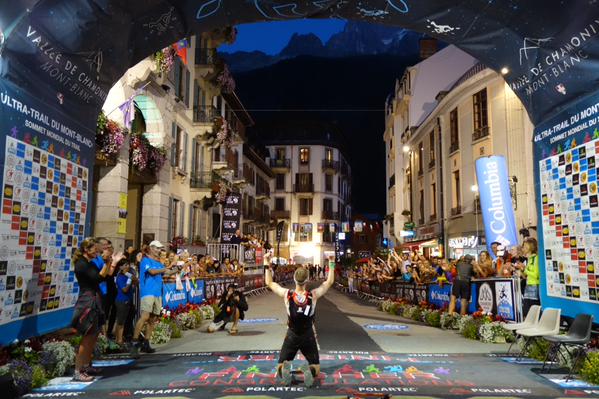The Outdoor Olympics / UTMB 100mile Footrace
– Why the world’s (unofficial) ultra running championship is unlike any other sporting event –
There was a moment during the Utra Trail du Mont Blanc live coverage this weekend, where we watched the Spaniard Luis Alberto Hernando walking along a mountain path in the Chamonix Valley, closely followed by the American Seth Swanson. The cameraman had been jogging spritely along infront of them for the last 3miles, on the steep dirt trail that lead to the Tete au Vent summit at mile 99. 1,000’s of viewers watched online as Alberto Hernando stopped, cupped his hands and took a slurp from a mountain brook, allowing the American to pass him at a brisk 4mph and move into 2nd place. The commentator, barely able to contain his excitement, declared that this was the equivalent to watching the outdoor Olympics. This strange sport that sees competitors run for as long as 46 hours, peel skin off their blistered feet and vomit by the side of the trail, was suddenly out there, and in the mainstream.

Damian Hall arrives back in Chamonix after lapping the highest mountain in Europe and travelling through France, Italy and Switzerland in a time of 26:41
Success in a 100mile race requires a fervent commitment to training. To tow the start line, the 2,300 competitors needed to have completed a minimum three events of 60+miles during the last 18months. Some runners will have completed more, preferring to train for the UTMB with lots of regular “shorter” events – where you run just a couple of marathons at a time. Others prefer to slog it out in training runs, spending 10 or more hours each weekend in the mountains. An exact formula for success in this multi sport refuses to be pinned down however. When the tape dropped on Chamonix’s high street last Friday at 6pm French time, the fortunes of the sport’s most shining lights were cast to the wind.
The challenges of this race are immense. Of the 5 runners that lead to the half way point, only 1 of them finished the race. Unfamiliarity with the terrain, poor shoe choice, over heating, dehydration, inability to hold down food and open wounds sustained on the trail led to many competitors retiring. For all but the most elite, two consecutive night of running were to be expected. During this time, the body enters such extreme states of fatigue that vivid hallucinations are experienced and runners fall asleep on their feet.
Besides the physical fatigue, the mental strain is soul-sucking. When the sun sets on a second day of non-stop running, and there are still 3 mountain passes to go on your bipedal trip through France, Switzerland and Italy, no amount of saucisson sec and cheese is going to get you to the finish. The desire to have done with the race is enormous. The lack of stimulation during the night that follows, where your world is reduced to a single beam of light, pushes competitors deeper still into their dark places, and it it easy to question the need to keep going.
Ultramarthon running is a very far cry from the marginal gain sport of professional cycling, or the style and finesse of elite level swimming. If this really is the closest we can get to an outdoor Olympics, and the sport’s popularity is to continue to grow, new audiences are going to have to adapt to the ultramarathon freak show format, and take a live broadcast vomit in their stride.
[:]

Leave a Reply
Want to join the discussion?Feel free to contribute!